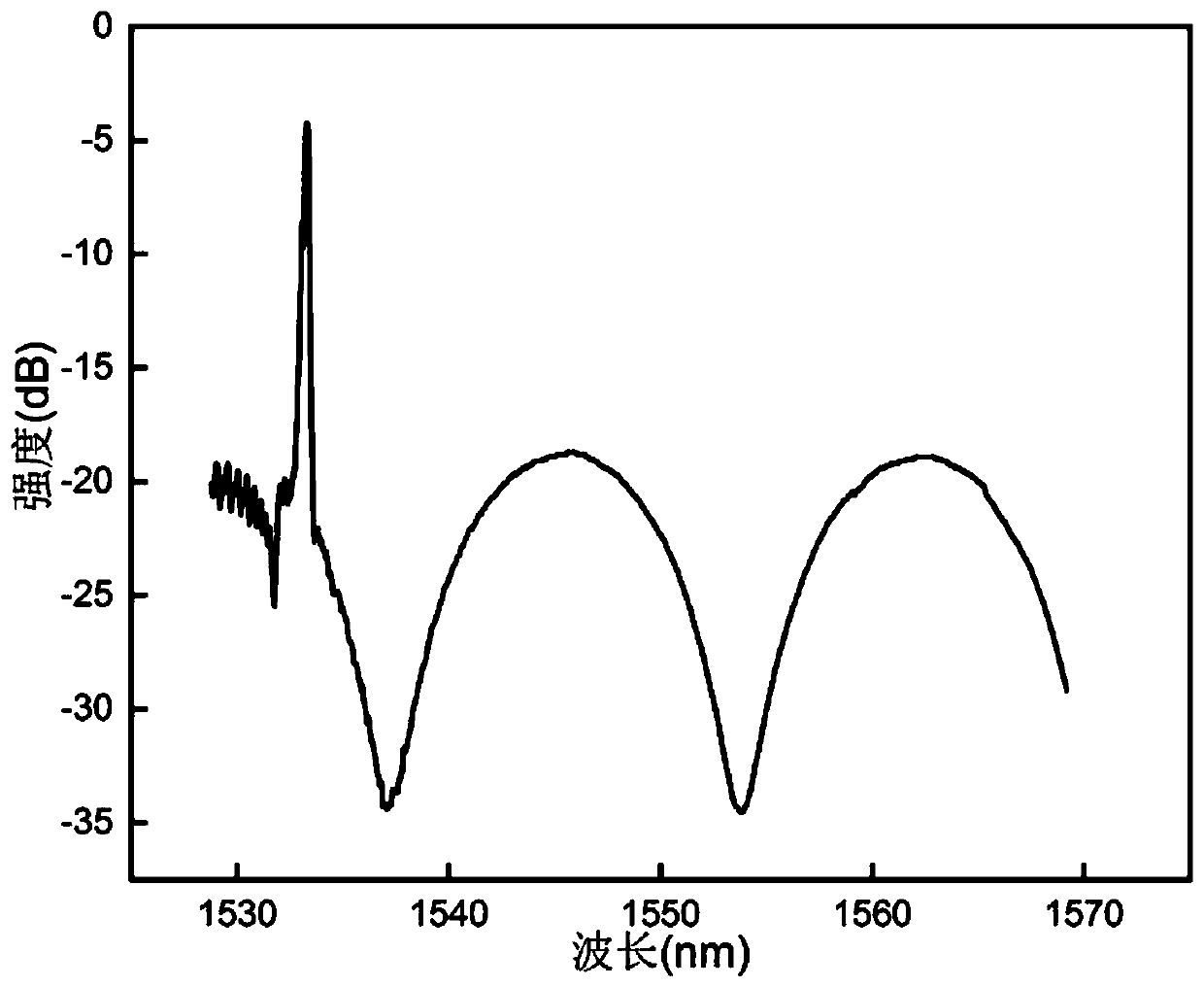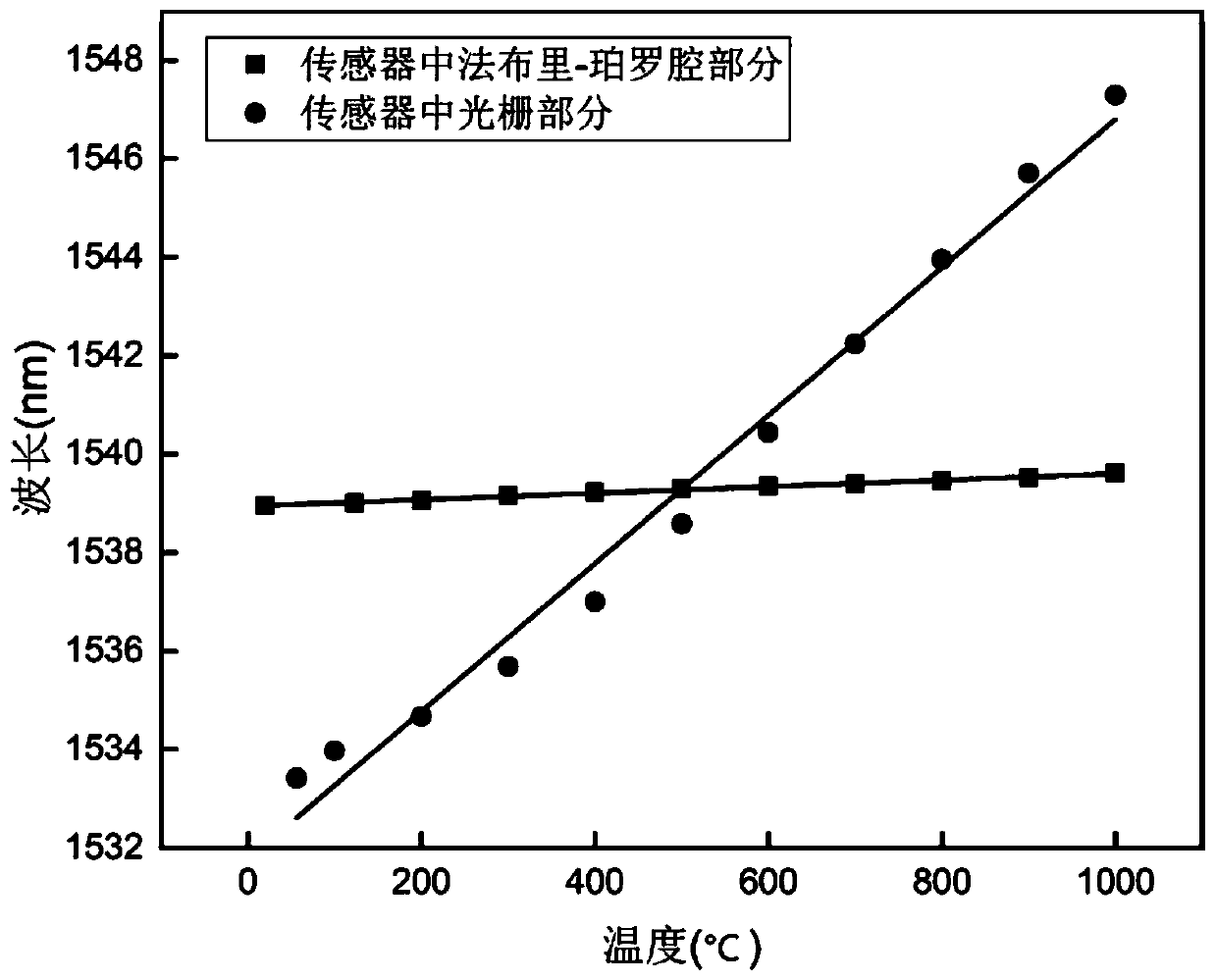High-temperature-resistant optical fiber strain sensor
An optical fiber strain and sensor technology, applied in the field of sensors, can solve the problems of unusable, small strain detection range and temperature detection range of optical fiber temperature strain sensor, achieve simple structure, improve strain sensitivity, and expand strain detection range and temperature detection range. Effect
- Summary
- Abstract
- Description
- Claims
- Application Information
AI Technical Summary
Problems solved by technology
Method used
Image
Examples
Embodiment 1
[0022] exist figure 1 Among them, the high-temperature resistant optical fiber strain sensor of this embodiment is composed of a first single-mode optical fiber 1, a hollow optical fiber 2, a high-temperature ceramic adhesive layer 3, a second single-mode optical fiber 4, a thermally regenerated fiber grating 5, and a capillary glass tube 6.
[0023] The inner diameter of the hollow fiber 2 of the present embodiment is 19 μm, and the left end of the hollow fiber 2 is axially welded with a first single-mode optical fiber 1 by laser welding, and arc welding can also be used, and the right end of the hollow fiber 2 is axially welded with a second fiber. The single-mode optical fiber 4, the first single-mode optical fiber 1 and the second single-mode optical fiber 4 are commodities sold in the market, the first single-mode optical fiber 1 and the second single-mode optical fiber 4 are SMF-28, and the core diameter is 8.2 μm , the cladding diameter is 125 μm, the splicing surface o...
Embodiment 2
[0029] The inner diameter of the hollow fiber 2 in this embodiment is 8 μm, the left end of the hollow fiber 2 is axially welded with a first single-mode fiber 1 by laser, and the right end of the hollow fiber 2 is axially connected with a second single-mode fiber 4 by laser fusion. The models of a single-mode optical fiber 1 and the second single-mode optical fiber 4 are the same as in Embodiment 1, the splicing surface of the first single-mode optical fiber 1 and the hollow-core optical fiber 2, the hollow-core optical fiber 2, the hollow-core optical fiber 2 and the second single-mode optical fiber The splicing surfaces of 4 together form a Fabry-Perot interference cavity. A thermally regenerated Bragg grating 5 is written on the second single-mode optical fiber 4 , the length of the thermally regenerated Bragg grating 5 is 10 mm, and the center wavelength is 1500 nm.
[0030] The right side of the second single-mode optical fiber 4 is coaxially bonded in the capillary glas...
Embodiment 3
[0033] The inner diameter of the hollow fiber 2 in this embodiment is 70 μm, the left end of the hollow fiber 2 is axially welded with a first single-mode fiber 1 by laser, and the right end of the hollow fiber 2 is axially connected with a second single-mode fiber 4 by laser fusion. The models of a single-mode optical fiber 1 and the second single-mode optical fiber 4 are the same as in Embodiment 1, the splicing surface of the first single-mode optical fiber 1 and the hollow-core optical fiber 2, the hollow-core optical fiber 2, the hollow-core optical fiber 2 and the second single-mode optical fiber The splicing surfaces of 4 together form a Fabry-Perot interference cavity. A thermally regenerated Bragg grating 5 is written on the second single-mode optical fiber 4 , the length of the thermally regenerated Bragg grating 5 is 10 mm, and the center wavelength is 1600 nm.
[0034] The right side of the second single-mode optical fiber 4 is coaxially bonded in the capillary gla...
PUM
| Property | Measurement | Unit |
|---|---|---|
| length | aaaaa | aaaaa |
| wavelength | aaaaa | aaaaa |
| diameter | aaaaa | aaaaa |
Abstract
Description
Claims
Application Information
 Login to View More
Login to View More - R&D
- Intellectual Property
- Life Sciences
- Materials
- Tech Scout
- Unparalleled Data Quality
- Higher Quality Content
- 60% Fewer Hallucinations
Browse by: Latest US Patents, China's latest patents, Technical Efficacy Thesaurus, Application Domain, Technology Topic, Popular Technical Reports.
© 2025 PatSnap. All rights reserved.Legal|Privacy policy|Modern Slavery Act Transparency Statement|Sitemap|About US| Contact US: help@patsnap.com



